Top 12 Quality Control Assistant Skills to Put on Your Resume
In the competitive field of quality control, having a resume that stands out is essential for landing a desirable position. Highlighting the top skills of a Quality Control Assistant not only showcases your expertise but also shows employers your drive to uphold tough standards and strengthen day-to-day operations.
Quality Control Assistant Skills
- ISO 9001
- Six Sigma
- Lean Manufacturing
- Statistical Analysis
- Minitab
- Quality Auditing
- SAP Quality Management
- Root Cause Analysis
- SPC (Statistical Process Control)
- GMP (Good Manufacturing Practices)
- CAPA (Corrective and Preventive Action)
- Quality Inspection
1. ISO 9001
ISO 9001 is the global benchmark for quality management systems (QMS). Organizations use it to prove they can consistently deliver products and services that meet customer and regulatory needs. For a Quality Control Assistant, it steers the setup and upkeep of processes, procedures, and roles that hit quality objectives and keep customers happy. Note: ISO 9001:2015 remains current, with a 2024 amendment highlighting climate-related considerations in context and management review.
Why It's Important
ISO 9001 helps lock in consistent quality and traceable processes, boosts customer satisfaction, and anchors continuous improvement. It gives clear, workable guidelines a Quality Control Assistant can rally around.
How to Improve ISO 9001 Skills
Sharpening ISO 9001 skills hinges on disciplined execution and relentless improvement:
Know the clauses cold: Understand requirements, risk-based thinking, process approach, and the 2024 climate considerations.
Invest in training: Internal workshops, peer learning, and role-based refreshers keep knowledge practical.
Run PDCA for real: Plan-Do-Check-Act on processes and metrics; track actions and close the loop.
Listen to customers: Capture feedback, complaints, returns, and field data; translate insights into improvements.
Strengthen internal audits: Use risk-based audit plans, clear checklists, and evidence-driven findings.
Use management reviews well: Bring meaningful data, trends, risks, and resource asks—seek decisions, not just minutes.
Make CAPA stick: Address root causes, verify effectiveness, prevent recurrence.
Tighten documentation: Keep procedures lean, version-controlled, and actually used on the floor.
Engage people: Align objectives with roles, recognize contributions, surface ideas from frontline teams.
Leverage quality tools: 5S, Kaizen, and visual management turn standards into habits.
How to Display ISO 9001 Skills on Your Resume
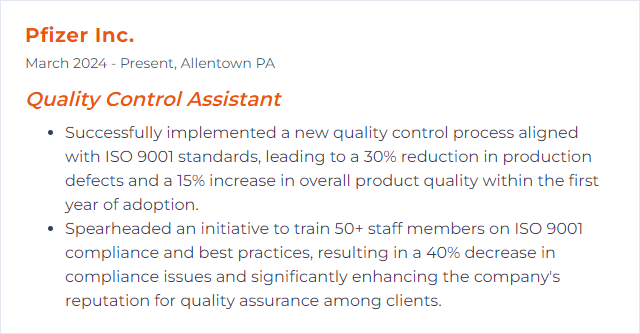
2. Six Sigma
Six Sigma is a data-first method to cut variation and defects through structured problem solving and statistical control, driving better quality and efficiency.
Why It's Important
It trims errors, stabilizes processes, and keeps outputs consistent—fuel for customer satisfaction and healthier margins. A Quality Control Assistant uses it to keep standards sharp and waste down.
How to Improve Six Sigma Skills
Build fluency and apply it where it matters:
Level up: Pursue belt-level learning that matches your role and responsibilities.
Master the toolsets: DMAIC/DMADV, hypothesis tests, capability, DOE—use the right tool for the right problem.
Run small projects: Tackle scoped issues end-to-end; document baselines, gains, and lessons.
Collaborate: Partner with production, maintenance, and supply teams; shared data uncovers hidden constraints.
Iterate fast: Pilot fixes, verify with data, then standardize and scale.
How to Display Six Sigma Skills on Your Resume

3. Lean Manufacturing
Lean Manufacturing is about banishing waste while boosting flow, quality, and value—seen through the eyes of the customer and the people closest to the work.
Why It's Important
Lean shortens lead times, raises first-pass yield, and cuts costs. That means fewer defects, calmer production, and cleaner handoffs—prime territory for a Quality Control Assistant.
How to Improve Lean Manufacturing Skills
Practical, everyday moves make Lean stick:
- Continuous improvement: Encourage daily Kaizen—micro-fixes add up.
- Standardize work: Clear, visual, stable steps reduce variation and surprises.
- 5S the workplace: Sort, Set, Shine, Standardize, Sustain—order drives quality.
- Visual management: Make status, limits, and abnormalities obvious at a glance.
- Root cause first: Use 5 Whys or fishbone diagrams to prevent repeat issues.
- Quality circles: Small, cross-functional groups solving problems regularly.
- Poka‑yoke: Error-proofing that stops defects before they’re born.
How to Display Lean Manufacturing Skills on Your Resume
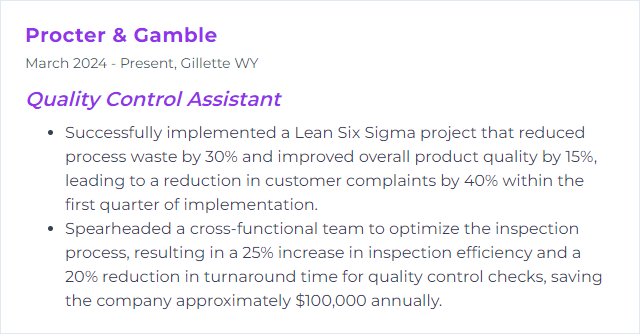
4. Statistical Analysis
In quality control, statistical analysis means collecting, exploring, and interpreting data to verify processes and products meet expectations. It flags trends, shifts, and outliers so decisions aren’t guesses—they’re grounded.
Why It's Important
It quantifies performance, reveals variability, and validates improvements. A Quality Control Assistant leans on it to cut defects, prove compliance, and keep processes predictable.
How to Improve Statistical Analysis Skills
Get precise, then get practical:
Solid fundamentals: Probability, sampling, distributions, confidence, and power—know the why behind the math.
Software fluency: Grow skills in tools such as Minitab, R, or Python for analyses and charts.
SPC in action: Apply control charts and capability analysis to monitor and improve live processes.
Descriptive vs. inferential: Summarize clearly; test hypotheses to support decisions.
Practice on real data: Work with shop-floor datasets, pilot runs, and historical trends; validate outcomes.
Keep learning: Short courses and peer reviews sharpen judgment and technique.
How to Display Statistical Analysis Skills on Your Resume
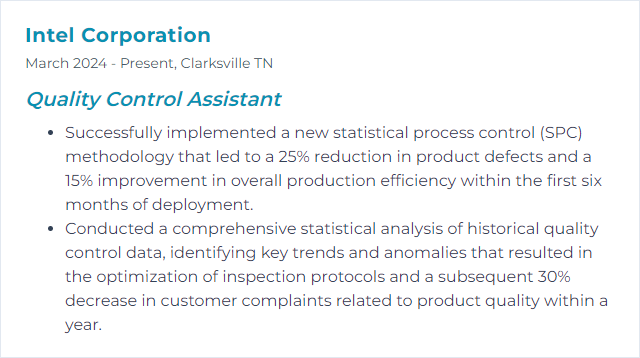
5. Minitab
Minitab is a statistics platform built for quality pros. It speeds up analyses, visualizes variation, and supports improvement projects with accessible, rigorous tools.
Why It's Important
It lets a Quality Control Assistant dig into data quickly—capability, control charts, regression, DOE—to spot trends, test fixes, and verify gains.
How to Improve Minitab Skills
Make every click count:
Learn the interface: Menus, worksheets, sessions, and graph builders—get comfortable navigating fast.
Build stats knowledge: Strong statistics makes features meaningful, not mysterious.
Template your work: Reusable macros, worksheets, and graph settings save time and standardize outputs.
Practice end-to-end: From data import to final report—replicate that flow until it’s smooth.
Explore advanced tools: Capability for nonnormal data, nested ANOVA, and DOE for multifactor problems.
Stay current: Track new features and adopt those that cut analysis time.
How to Display Minitab Skills on Your Resume
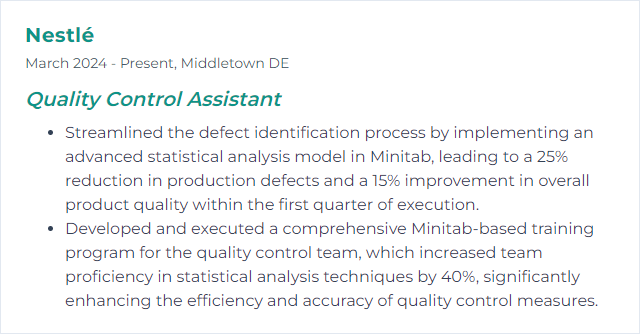
6. Quality Auditing
Quality auditing is a systematic check of the quality system—policies, processes, and records—by internal or external auditors. It verifies conformance, uncovers risks, and triggers improvements. A Quality Control Assistant often prepares evidence, supports audit activities, and follows through on actions.
Why It's Important
Audits validate that standards are met, reveal weak points before they break, and protect compliance and reputation. They also feed continuous improvement with concrete findings.
How to Improve Quality Auditing Skills
Make audits sharper and more useful:
Strengthen knowledge: Stay current on applicable standards, procedures, and regulatory expectations.
Use structure: Risk-based audit plans, scope clarity, and evidence-focused checklists keep audits balanced and thorough.
Adopt smart tools: Digital checklists, issue trackers, and document control improve accuracy and traceability.
Close the loop: Turn findings into disciplined CAPA with clear owners and dates; verify effectiveness.
Engage stakeholders: Communicate early, share criteria, and align on expectations to reduce defensiveness and speed fixes.
Reflect and refine: After each audit, review what worked and what didn’t; improve the approach.
How to Display Quality Auditing Skills on Your Resume
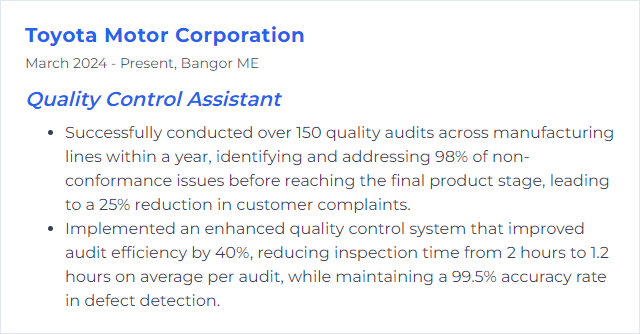
7. SAP Quality Management
SAP Quality Management (QM) is the SAP component that handles quality planning, inspection, and control—integrated across procurement, production, and logistics. In S/4HANA, QM links tightly with Fiori apps and analytics, giving a Quality Control Assistant the data and workflows to manage nonconformances, inspections, and certifications.
Why It's Important
It standardizes how quality data is captured and acted on, reduces manual errors, and supports compliance. The result: consistent outputs, faster resolution of issues, and fewer costly surprises.
How to Improve SAP Quality Management Skills
Turn the system into an advantage:
Know the scope: Inspection lots, plans, results recording, quality notifications, and usage decisions—understand how they fit together.
Automate where sensible: Barcoding, interfaces, and guided procedures cut entry errors and speed throughput.
Use analytics: Configure reports and dashboards for scrap, defects, and trends; drive action from insights.
Tidy master data: Clean catalogs, MICs, sampling procedures, and inspection plans—bad data wrecks good systems.
Integrate CAPA: Link notifications to root cause, actions, and effectiveness checks.
Adopt Fiori: Role-based apps simplify transactions and improve adoption on the floor.
Train continuously: Short, targeted sessions keep users confident and consistent.
How to Display SAP Quality Management Skills on Your Resume
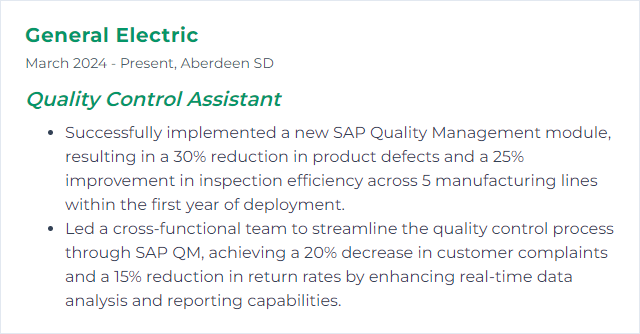
8. Root Cause Analysis
Root Cause Analysis (RCA) is the disciplined hunt for the underlying reason a defect or failure happened—so you can fix the cause, not just the symptom.
Why It's Important
It prevents repeat issues, stabilizes processes, and protects quality. Without it, problems relapse and costs climb.
How to Improve Root Cause Analysis Skills
Make investigations crisp and conclusive:
Define precisely: What happened, when, where, how often, and how bad—anchor the problem with data.
Collect evidence: Logs, samples, photos, histories, and process data—separate facts from guesses.
Use structured tools: 5 Whys, fishbone, fault tree, and is/is-not framing.
Validate causes: Test hypotheses against data; don’t stop at the first plausible answer.
Implement targeted actions: Address the cause directly; prioritize high-impact, feasible fixes.
Verify effectiveness: Track post-action metrics and confirm the issue stays gone.
Document and share: Capture the journey and the learning to prevent déjà vu.
How to Display Root Cause Analysis Skills on Your Resume

9. SPC (Statistical Process Control)
SPC uses statistics to watch and control a process. With control charts and capability analysis, you can catch shifts early, separate common from special causes, and keep output steady.
Why It's Important
It minimizes variability, cuts defects, and stabilizes performance—the heartbeat of reliable quality. Perfect territory for a Quality Control Assistant to shine.
How to Improve SPC (Statistical Process Control) Skills
Dial in the discipline:
Train the team: Everyone touching the process should know how to read a chart and respond.
Protect data integrity: Calibrated gauges, clear sampling plans, automated capture where possible.
Map processes: Find critical control points and measure what truly matters.
Pick the right charts: X‑bar/R, I‑MR, p/np, c/u—match chart to data type and subgrouping.
Act on signals: Define standard responses to rules violations and trends.
Review regularly: Reassess control limits and capability when processes change.
Embed ownership: Make SPC part of daily management, not a side project.
How to Display SPC (Statistical Process Control) Skills on Your Resume
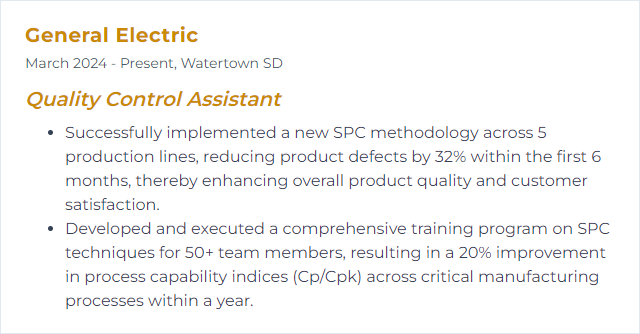
10. GMP (Good Manufacturing Practices)
GMP lays out the guardrails for consistent, controlled production—materials, equipment, premises, hygiene, training, documentation. A Quality Control Assistant helps ensure those rules are followed, verified, and recorded.
Why It's Important
It protects safety, quality, and efficacy, reducing risks that end-of-line tests can’t catch. It also underpins compliance with regulators and customer requirements.
How to Improve GMP (Good Manufacturing Practices) Skills
Build reliability into the fabric of work:
Train continuously: Short, scenario-based refreshers keep procedures alive and relevant.
Strengthen documentation: Clear SOPs, version control, change management, and accessible records.
Improve QC systems: Periodically review sampling plans, test methods, and equipment qualification.
Audit proactively: Internal audits and Gemba walks reveal gaps early.
Close CAPA effectively: Root cause, targeted fixes, and verified effectiveness.
Foster culture: Encourage speaking up, swift deviation reporting, and learning from near misses.
How to Display GMP (Good Manufacturing Practices) Skills on Your Resume
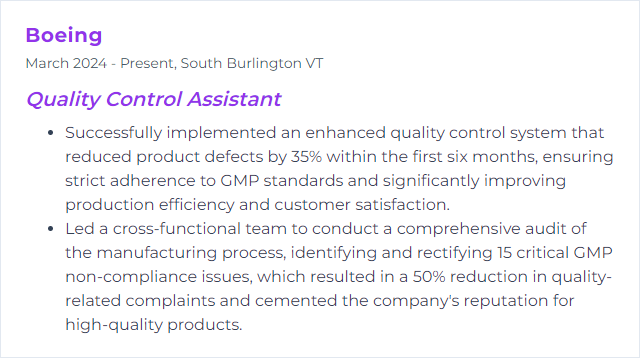
11. CAPA (Corrective and Preventive Action)
CAPA is the engine that fixes problems for good. Corrective actions address what happened; preventive actions guard against it happening again.
Why It's Important
It drives compliance, protects quality, and boosts customer trust by stopping repeat defects and system weaknesses.
How to Improve CAPA (Corrective and Preventive Action) Skills
Make CAPA rigorous, not paperwork:
Define and document: Clear problem statements with evidence, scope, and risk.
Analyze deeply: Root cause before remedy; verify cause-and-effect.
Plan smart: Set specific, measurable goals, owners, timelines, and resources.
Execute visibly: Track actions to closure with status, blockers, and handoffs.
Verify outcomes: Measure effectiveness with before/after data; keep changes if they work.
Standardize learning: Update SOPs, training, and risk assessments to lock in the gains.
How to Display CAPA (Corrective and Preventive Action) Skills on Your Resume

12. Quality Inspection
Quality Inspection checks materials, components, and finished goods against specified standards to decide accept or reject. It’s a frontline safeguard run by a Quality Control Assistant to keep only conforming product moving forward.
Why It's Important
Inspection catches defects early, protects safety, and sustains customer confidence. It also feeds upstream teams with evidence to fix what’s broken.
How to Improve Quality Inspection Skills
Make inspections crisp, consistent, and fast:
Standardize methods: Clear criteria, sampling plans, and acceptance limits remove guesswork.
Calibrate and qualify: Keep gauges calibrated, methods validated, and inspectors trained.
Use automation when possible: Vision systems, digital checklists, and e-signatures reduce human error.
Integrate SPC: Monitor trends to shift from detection to prevention.
Tighten supplier quality: Incoming inspections and supplier feedback loops prevent bad flow-in.
Close feedback loops: Share inspection findings with production and engineering for rapid fixes.
How to Display Quality Inspection Skills on Your Resume

